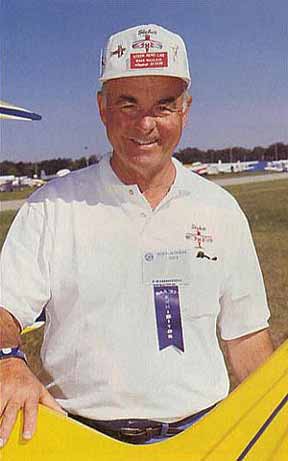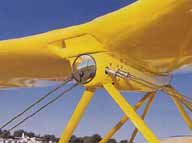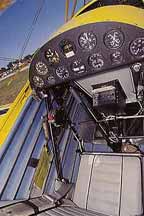When this was written, Hale Wallace was still very much alive and
contributing mightly to the world of homebuilding in general and the
world of the biplane in particular. He taught me a lot of things during
our three decade friendship but the one I'd like to pass on that I took
the most to heart has nothing to do with airplanes. Hale died simply
because he got lazy about going to the doctor and hadn't had a PSA test
for at least five years. None of us should do that. It would have been
a simple operation, had he just gone to the doctor once a year. But
he didn't and all of his friends paid the price of his passing. If you
take nothing else from this article, take with you the knowledge that
simple annual check ups can save your life and, in so doing, prevent
an enormous amount of pain to your friends and family. Sermon over.
My mind was in biplane mode: Head back, vision foreshortened and out
of focus so my eyes were staring straight ahead, my peripheral vision
watching both sides of the runway at the same time. I was seeing everything
but focusing on nothing. My left hand started forward and what had been
a steady rumble from under the cowl which rocked the Skybolt even as
it sat on the end of the grass runway became an enraged beast. The airplane
lunged forward, the wall of noise rolled back over me and I had the
weirdest feeling I had just passed beneath a lion's fangs and was rocketing
out the back side of his maw.
325 horses were reducing the hangars and edges of the runway at Shiftlet
Field, Marion, North Carolina to meaningless blurs. They were of no
consequence. Only the shallow circle which encompassed the airplane's
nose and the edges of the runway counted.
| |
 |
| |
The master himself: the late Hale Wallace.
The Skybolt is now kept alive by Steen Aerolab www.steenaerolab.com.
|
I kept waiting for the acceleration to let up. For the speed to become
constant. As the tail came up and more of the runway came into view,
the seat kept insisting itself upon my backside. The runway kept flashing
past and I approximated a slightly tail down attitude. Taking a second
breath hadn't yet occurred to me when the airplane skipped once and
clawed its way into the air.
I glanced at the airspeed. It was already racing through 110 mph so
I pulled the nose up. Then more. I stopped at what looked like a suitably
ridiculous angle that held the 110 mph. The VSI was lounging around
2400 fpm.
So this is what happens when the boss builds himself an airplane. This
is what a Skybolt feels like when Hale Wallace, operator of Steen Aero
Labs (704-652-7382) home of the Skybolt builds one for himself.
Hale spends most of his waking hours working on biplanes and components
for them. He not only is the exclusive distributor for Brunton flying
wires (which makes him the sole source for ALL flying wires since MacWhyte
closed down) but he also owns the rights and sells plans for the S-1C
series of Pitts Specials, including the Super Stinker wing update for
the four-cylinder airplanes. He has the same rights and plans for the
Knight Twister (he'll have one of them at Oshkosh next year, and is
it ever cute!). On top of that, he is the exclusive US distributor for
the Hoffman series of fixed and constant speed propellers.
Most of what Steen Aero Lab does, however, has to do with Skybolts:
Plans, finished components up to wings and fuselages, Hale Wallace is
Mr. Skybolt, world wide.
So, when Mr. Skybolt decides to build himself an airplane, what makes
it different than the rest?
"Basically, this airplane is built right to the plans," says
Wallace. "We did, however spend a lot of time at reducing weight
ever where we could. For instance, for the firewall, we used .020"
titanium, which not only saved around six pounds, but titanium is much
easier to work than stainless steel."
Titanium is use liberally through out the airplane and each use is documented
by engineering back-up.
"All of the heavy bolts, like attach bolts, are titanium. So are
the drag/anti-drag wires and all the push-pull tubes. We used it every
where it made sense and the numbers looked okay," he says.
"We used the Hague locking tailwheel for a number of reasons, weight
being one of them," Hale points out. "It's three or four pounds
lighter. It also, however, lets us get the tail down another couple
inches and we need the prop clearance."
Although the wings are still basic Skybolt, there too Wallace has put
his experience to work.
"The wing spars are routed, using a hard tooling template we've
developed. That alone saves about 15 pounds an airplane depending on
wood density. In total, we've knocked about 30-35 pounds out of the
wings alone," he says.
In building the wings, he also put his experience to work to get the
most roll performance possible out of the basic Skybolt wing design.
He has done Skybolt wings using the Pitts Super Stinker aileron technology
(symmetrical ailerons with special nose profile), but decided to stay
with the normal ailerons on this one.
Wallace says, "Good roll rate and response is due as much to the
fit of the ailerons as their design. What we do is finish the wing up
through the first coat of silver while working at getting all of our
aileron gaps down to less than a quarter of an inch. Then we close up
as much of that gap as possible with balsa filler strips and put the
finish tapes over the balsa. By waiting to finish the aileron wells
until after the fabric is fairly tight, we eliminate the problems of
distorting the aileron wells in the final covering steps."
Wallace is especially proud of the canopy on the airplane.
| |
 |
| |
Hale's airplanes always abound in ridiculously
tidy details that make the rest of us feel like butchers. |
"Anyone who has ever done a canopy installation on an airplane
swears they'll never do another, " Wallace laughs. "This canopy
solves the problem of making everything fit because you build it on
the airplane. I saw a photo of a similar type of canopy on a Skybolt
built by Francois Mounier-Poulat in France 20 years ago. Francois ,
by the way, is now my sales representative over there. We took the concept
and refined it. The entire assembly only weights about 12 pounds, which,
if you subtract the weight of the open cockpit windshields only adds
about 10 pounds to the airplane."
The canopy bubble is glassed into a form-fitting apron and attached
to the airplane by a trapezoidal steel tube frame which swings from
behind the pilot, when open, and lays on the longerons, when closed.
A spreader bar bridging over the instrument panel is made of cross-grain
balsa for light weight and easy bending and is captured in glass cloth
and epoxy for rigidity. The bar is only there for a handhold, according
to Wallace. The bubble pivots up and back, completely opening up both
pits for exit and entry.
Another aspect of Wallace's bullet is the engine. Hale went to Monte
Barrett, who is best known as one of the premier builder of aerobatic
engines, but is now accepting orders for more "normal" engines.
Normal in this case included taking a lowly 235 hp 0-540 Lycoming and
swapping parts around until it was putting out close to 325 hp on the
dyno. This includes one of Barrett's cold-air induction units.
As the US Hoffman importer, it is no surprise one of their three-blade,
composite props caps off the propulsion department on the Wallace Skybolt.
The airplane is finished in Randolph dope
| |
 |
| |
I wish this was a bigger photo but it's
the biggest, I have. Sorry. |
"For health reasons, I try to stay away from any of the polyurethanes,"
Wallace explains.
"Also, I always use Razorback on the fuselage because it is nearly
bullet proof and has a neat appearance on the inside. I'd prefer to
use cotton on the wings, but you can't find good cotton, so I use dacron
like everybody else."
What ever he uses, the airplane looks terrific!
As I climbed on board Wallace's airplane, I'll have to admit I first
thought the canopy arrangement to be a little fragile looking and probably
hard to manage. I was wrong on both scores. All I had to do was reach
behind my head and urge it forward until the canopy pivoted down and
I held it by the spreader bar. There couldn't have been more then a
pound or two in my hand. It was necessary to pivot the canopy so the
nose was pointed down hill. From then on, it was a simple matter of
dropping it into place and locking the two canopy latches. To jettison
it, all I had to do was pull a pit-pin on either side of the cockpit.
Hale had warned me to keep the stick back while the engine was running
because letting the stick forward could raise the tail with the smallest
application of power. As I moved out towards the runway, I could see
what he was talking bout. There was absolutely no doubt that there was
a truck load of horsepower under the hood.
| |
 |
| |
The Monte Barrett massaged 0-540 with
its high compression pistons and cold air induction pumped out
325 hp on the dyno and, when you dropped the hammer, you felt
every one of those horse. Very cool! |
I'm not a fan of locking tailwheels on little airplanes, but this one
worked quite well. Wallace had used the throttle assembly off a lawnmower
as the engage mechanism which was located under my left hip. With the
tailwheel locked, it drew a rail-straight line. With it unlocked, the
airplane was perfectly willing to go someplace else and took some brake
to stay on top of it.
That first takeoff was exhilarating, to say the least. It was right
up there with any of the rocket-powered aerobatic specials. Just keeping
the speed down to an acceptable level during the climb was an interesting
chore. Later I tried climbing at best rate, which is down around 90
mph, and the angle had to be approaching 45 degrees. It was ridiculous
and fun at the same time. The rate of climb was well over 3,000 fpm.
In a couple of minutes after that first takeoff, I was at 5,000 feet
and let the nose down and the speed build. And build. Showing 2350 square,
it stabilized at about 165 mph indicated which at that altitude and
temperature was well over 170 mph TAS. This has to be the fastest Skybolt
in history! Hale said his two way average going to Tulsa for the biplane
bash was 176 mph at less than 13 gph. Now, that's hauling for a big
biplane!
Incidentally, I tried running at reduced power settings just to see
how much of the speed was due to brute horsepower and how much was airframe
related. Backing the power off to what I guessed to be more normal power,
only brought the airplane down to about 150 indicated, so it was still
quite fast. This is undoubtedly because the airplane was probably the
straightest Skybolt ever built.
This airplane was an easy 35 mph faster than any Skybolt I'd ever sat
in and that extra speed was noticeable in a number of ways. At normal
Skybolt speeds, the aileron pressures were lighter than most I'd flown,
about on a par with a Pitts S-2A with fairly quick response. Don't forget,
a Skybolt is much larger than a Pitts, so shouldn't be as nimble, but
it's closer than you'd think. As the speed went up, the pressures built
slightly until they were about the same as the S-2B, but the roll rate
increased at the same time.
| |
 |
| |
Just your basic, snarling beast of a
biplane, that has the manners of a pussy cat. This is a hard airplane
not to love. |
The canopy seemed to let the entire world into the bigger than average
cockpit. That's always been one of the Skybolt's strong points: It's
cockpit size and shape makes it really comfortable. You're sitting there,
legs spread wide, laying back at just enough angle for it to be easy
on beat up backs like mine, while the incredibly smooth Lycoming up
front is helping you stack up the miles. No homebuilt biplane is Cessna-stable
but the Skybolt comes close. Combine that with a good GPS and the urge
to go someplace usually can't, and shouldn't, be resisted.
The airplane had so much more straight level speed than most Skybolts
that dropping the nose for any kind of overhead maneuver was overkill.
It was perfectly happy to loop out of level flight and hold its altitude.
In fact, if you weren't careful, you'd gain altitude. It would do a
half-vertical roll from max level with a hammerhead turnaround and another
half roll on the way down without breathing hard. Dropping the nose
just a tad gave 200 mph and it would do anything from that speed.
The speed gave the airplane a ballistic feeling that I generally assume
to be coupled with a much higher wing loading. This lead to a mis-perception
on my part. It felt like a heavy airplane, so I flew approach like it
was a heavy airplane. Here again, I was wrong. Let the record show that
90 mph over the fence is entirely too fast for the airplane. After a
lovely, easy to control, slipping approach, I blew it and floated half
the length of the runway before it decided to land.
Power up, let's try that again.
This time it was 85 mph. Skybolts are all wonderful slipping airplanes
which does away with any blindness factor until just about ready to
touch down. Even then, the visibility is much better than most taildraggers.
Let the record show that 85 mph is still too fast. Too much float. Too
much runway behind me on touch down.
It became obvious the diet Wallace put this airplane on had paid off
and it was going to take a bunch more approaches before I had it figured
out. What I didn't have to figure out, however, was the ground roll.
Once it touched down, I'm not certain I moved my feet at all. Most Skybolts
are pussy cats, but this one was nose-wheel simple. Maybe there's something
to this locking tailwheel thing after all.
Ignoring the massive amount of power, the most important factor one
should bring away from studying Hale Wallace's personal Skybolt is that
attention to detail pays off. There was nothing about the airplane that
was overtly fancy. No chrome. No super-stitched upholstery. No fancy
anything. However, there was absolutely nothing out of line. No gaps
that were uneven. Everything was simply "right." It all fit
and lined up. That meant the airplane flew the same way. It was absolutely
one of the most die-straight airplanes I've ever sat in and that alone
made it a pleasure to fly. Toss in 325 of Barrett's famous ponies and
what's not to like?
When the boss builds an airplane for himself, he builds it the way he
wishes everybody would and it shows.

